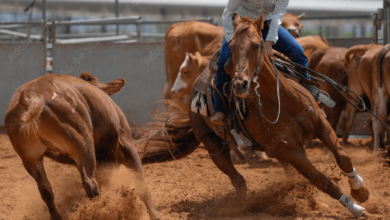What are the key components of an advanced dressage routine?

Understanding the key components of an advanced dressage routine is crucial for anyone aiming to excel in this discipline. These components include the horse’s ability to perform precise and intricate movements, the rider’s skill in guiding and communicating with the horse, and the harmony between the pair.
Understanding Advanced Dressage Movements
Collection, Extension, Flying Changes
Advanced dressage movements such as collection, extension, and flying changes are essential. Collection refers to the horse’s ability to carry more weight on its hindquarters, allowing for more elevated and controlled movements. Extensions, on the other hand, are the horse’s lengthened strides, showcasing its power and grace. Flying changes are a dynamic movement where the horse changes leads at the canter without breaking stride.
The Importance of Rhythm and Tempo in Dressage
Maintaining Consistent Tempo, Adjusting Rhythm for Different Movements
A consistent rhythm and tempo are the foundations of any dressage routine. Maintaining a steady tempo helps in executing movements fluidly, while adjusting rhythm is necessary for different elements, such as transitions and extensions, ensuring each movement is distinct and well-defined.
Developing Collection in Dressage
Exercises to Improve Collection, Role of Collection in Advanced Movements
Developing collection involves specific exercises that encourage the horse to engage its hindquarters more effectively. This can include transitions between gaits, half-halts, and lateral movements. Collection is vital in advanced movements like pirouettes and piaffes, requiring the horse to carry itself in a more balanced and controlled manner.
Mastering Extensions in Dressage
Techniques to Enhance Extensions, Common Challenges and Solutions
Extensions demonstrate the horse’s power and fluidity. To master extensions, riders should focus on developing the horse’s strength and flexibility through exercises like lengthening and shortening strides. Common challenges include maintaining balance and avoiding rushing, which can be addressed through consistent practice and expert guidance.
Executing Flying Changes
Step-by-Step Guide, Common Mistakes and Corrections
Flying changes are a highlight of advanced dressage routines, showcasing the horse’s agility and the rider’s precision. A step-by-step approach involves practicing simple changes, then progressing to more complex sequences. Common mistakes, such as late or unbalanced changes, can be corrected by improving the horse’s straightness and the rider’s timing.
The Role of Transitions in Dressage
Importance of Smooth Transitions, Practicing Transitions Effectively
Smooth transitions between gaits are essential for maintaining rhythm and balance in a dressage routine. Practicing transitions helps improve the horse’s responsiveness and the rider’s ability to give clear aids. Effective transitions are characterized by seamless changes in gait without disrupting the flow of the routine.
Pirouettes: The Ultimate Test of Balance
Training for Pirouettes, Common Issues and Fixes
Pirouettes are a test of the horse’s balance and the rider’s control. Training for pirouettes involves exercises that enhance the horse’s collection and ability to pivot around its hindquarters. Common issues include losing balance or over-rotating, which can be addressed through targeted training drills and corrective feedback.
Half-Pass and Shoulder-In: Building Lateral Suppleness
Drills to Improve Lateral Movements, Benefits in Advanced Routines
Lateral movements like the half-pass and shoulder-in are crucial for building suppleness and flexibility. Drills that encourage lateral movement help improve the horse’s ability to bend and move sideways, essential for executing complex dressage routines with fluidity and grace.
The Piaffe and Passage: Pinnacle of Dressage
Training Techniques, Differences Between Piaffe and Passage
The piaffe and passage are pinnacle movements in advanced dressage, showcasing the horse’s strength and precision. The piaffe is a trot in place, requiring high levels of collection, while the passage is a highly elevated trot with a distinctive rhythm. Training for these movements involves developing the horse’s strength, balance, and responsiveness to subtle aids.
Developing Straightness and Alignment
Exercises to Improve Straightness, Importance in Routine Execution
Straightness and alignment are critical for the execution of dressage movements. Exercises that focus on maintaining a straight line, such as riding along the rail or using ground poles, help ensure the horse moves correctly and symmetrically, which is essential for achieving high scores in competition.
Building Impulsion for Advanced Movements
Strategies to Enhance Impulsion, Common Training Practices
Impulsion refers to the horse’s energy and drive from the hindquarters, crucial for advanced dressage movements. Strategies to enhance impulsion include using transitions, varying the length of strides, and incorporating pole work. Regular practice of these techniques helps maintain the horse’s energy and responsiveness.
The Rider’s Role in Advanced Dressage
Importance of Rider’s Position, Aids and Communication
The rider’s position and aids are pivotal in advanced dressage. A balanced and correct position allows for effective communication with the horse, while clear and consistent aids ensure the horse understands and responds accurately. Regular training and feedback from a coach can help refine these skills.
Importance of Horse and Rider Fitness
Conditioning Programs, Preventing Injuries
Fitness is vital for both horse and rider in advanced dressage. Conditioning programs that include strength training, cardio, and flexibility exercises help maintain peak performance and prevent injuries. It’s essential to tailor these programs to the individual needs of the horse and rider.
Mental Preparation for Advanced Dressage
Techniques for Mental Focus, Handling Performance Pressure
Mental preparation is as important as physical training in dressage. Techniques such as visualization, deep breathing, and mindfulness help improve focus and manage performance pressure. Building a strong mental routine ensures both horse and rider can perform at their best under competition conditions.
Using Ground Poles and Cavaletti in Training
Benefits for Dressage Horses, Sample Exercises
Incorporating ground poles and cavaletti into training routines offers numerous benefits, including improving the horse’s coordination, balance, and muscle development. Sample exercises might include trot and canter pole work, which helps in refining the horse’s stride and rhythm.
The Significance of Dressage Tests and Scores
Understanding Scoring Criteria, Improving Test Performance
Understanding the scoring criteria of dressage tests is crucial for improving performance. Judges evaluate based on factors such as rhythm, suppleness, and precision of movements. Focusing on these criteria during training helps in delivering a polished and high-scoring routine.
Common Mistakes in Advanced Dressage and How to Avoid Them
Identifying Errors, Corrective Measures
Common mistakes in advanced dressage include lack of straightness, inconsistent rhythm, and unclear aids. Identifying these errors early and implementing corrective measures, such as targeted exercises and professional feedback, ensures continuous improvement and refinement of skills.
The Impact of Diet and Nutrition on Performance
Optimal Diet Plans, Supplements for Dressage Horses
A balanced diet and proper nutrition significantly impact a dressage horse’s performance. Optimal diet plans include high-quality forage, balanced grains, and necessary supplements. Consulting with a veterinary nutritionist ensures the horse receives the nutrients required for peak performance.
Selecting the Right Equipment for Advanced Dressage
Saddles, Bridles, and Bits for High-Level Performance
Choosing the right equipment, such as saddles, bridles, and bits, is essential for advanced dressage. Properly fitting equipment ensures the horse’s comfort and allows for effective communication between horse and rider. Regular checks and adjustments help maintain the equipment’s functionality.
The Role of Professional Coaching in Dressage
Finding the Right Coach, Benefits of Regular Lessons
Professional coaching plays a significant role in advancing dressage skills. Finding the right coach involves considering their experience, teaching style, and compatibility with the horse and rider. Regular lessons provide ongoing feedback and guidance, essential for continuous improvement.
Incorporating Cross-Training into Dressage Routines
Advantages of Cross-Training, Suggested Activities
Cross-training offers numerous benefits for dressage horses, including improved fitness, mental stimulation, and reduced risk of overuse injuries. Suggested activities include trail riding, jumping, and lunging. These activities complement dressage training by enhancing overall performance and wellbeing.
The Evolution of Dressage Training Methods
Historical Perspectives, Modern Techniques
Dressage training methods have evolved significantly over time, from classical techniques to modern approaches that incorporate scientific insights. Understanding this evolution helps riders appreciate traditional methods while embracing innovative practices that enhance training efficiency and effectiveness.
Creating a Tailored Training Plan for Your Horse
Steps to Develop a Custom Plan, Monitoring Progress
Creating a tailored training plan involves assessing the horse’s strengths and weaknesses, setting specific goals, and designing exercises that address these areas. Regular monitoring and adjustments ensure the plan remains effective and aligned with the horse’s development and competition schedule.
The Importance of Regular Veterinary Check-Ups
Identifying Health Issues Early, Maintaining Peak Condition
Regular veterinary check-ups are crucial for identifying health issues early and maintaining the horse’s peak condition. Routine examinations, vaccinations, and dental care are essential components of a comprehensive health maintenance plan, ensuring the horse remains fit and healthy.
The Influence of Genetics on Dressage Ability
Breeding Considerations, Selecting a Dressage Prospect
Genetics play a significant role in a horse’s dressage ability. Breeding considerations include selecting horses with proven performance bloodlines and desirable traits such as temperament, conformation, and movement. Understanding these factors helps in selecting a promising dressage prospect.
Balancing Work and Rest in Training Schedules
Optimal Training Schedules, Importance of Rest Days
Balancing work and rest is vital for effective training schedules. Overworking can lead to burnout and injuries, while adequate rest allows for recovery and consolidation of skills. An optimal schedule includes regular training sessions interspersed with rest days and lighter activities.
The Future of Dressage Competitions
Trends and Innovations, Preparing for Future Competitions
The future of dressage competitions may see trends such as increased emphasis on horse welfare, advanced training technologies, and evolving judging criteria. Preparing for these changes involves staying informed about industry developments and adapting training methods accordingly.
Tips for Competing at International Dressage Events
Travel Tips, Handling Competition Stress
Competing at international dressage events requires careful planning and preparation. Travel tips include ensuring the horse’s comfort during transport, complying with international regulations, and managing logistics. Handling competition stress involves maintaining a consistent routine, mental preparation, and staying focused on performance goals.
FAQs
What are the essential movements in advanced dressage? The essential movements in advanced dressage include collection, extensions, flying changes, pirouettes, piaffe, and passage. These movements demonstrate the horse’s agility, balance, and responsiveness.
How can I improve my horse’s collection? Improving collection involves exercises that engage the hindquarters, such as transitions, half-halts, and lateral movements. Consistent practice and professional guidance help in developing effective collection.
Why is rhythm and tempo important in dressage? Rhythm and tempo are crucial for maintaining the flow and precision of dressage movements. A consistent tempo ensures fluid transitions and extensions, while an appropriate rhythm helps in executing each movement distinctly.
What equipment is recommended for advanced dressage? Recommended equipment for advanced dressage includes well-fitting saddles, bridles, and bits that ensure the horse’s comfort and allow for effective communication. Regular equipment checks and adjustments are essential.
How can cross-training benefit my dressage horse? Cross-training benefits dressage horses by improving overall fitness, providing mental stimulation, and reducing the risk of overuse injuries. Activities such as trail riding, jumping, and lunging complement dressage training.
What should I consider when selecting a dressage prospect? When selecting a dressage prospect, consider genetics, conformation, temperament, and movement. Horses with proven performance bloodlines and desirable traits are more likely to succeed in dressage.
Conclusion
Advanced dressage routines are a blend of precision, grace, and partnership between horse and rider. Understanding and mastering the key components of these routines, from intricate movements to mental preparation, is essential for success. With dedicated training, the right equipment, and professional guidance, achieving excellence in advanced dressage is an attainable goal.







